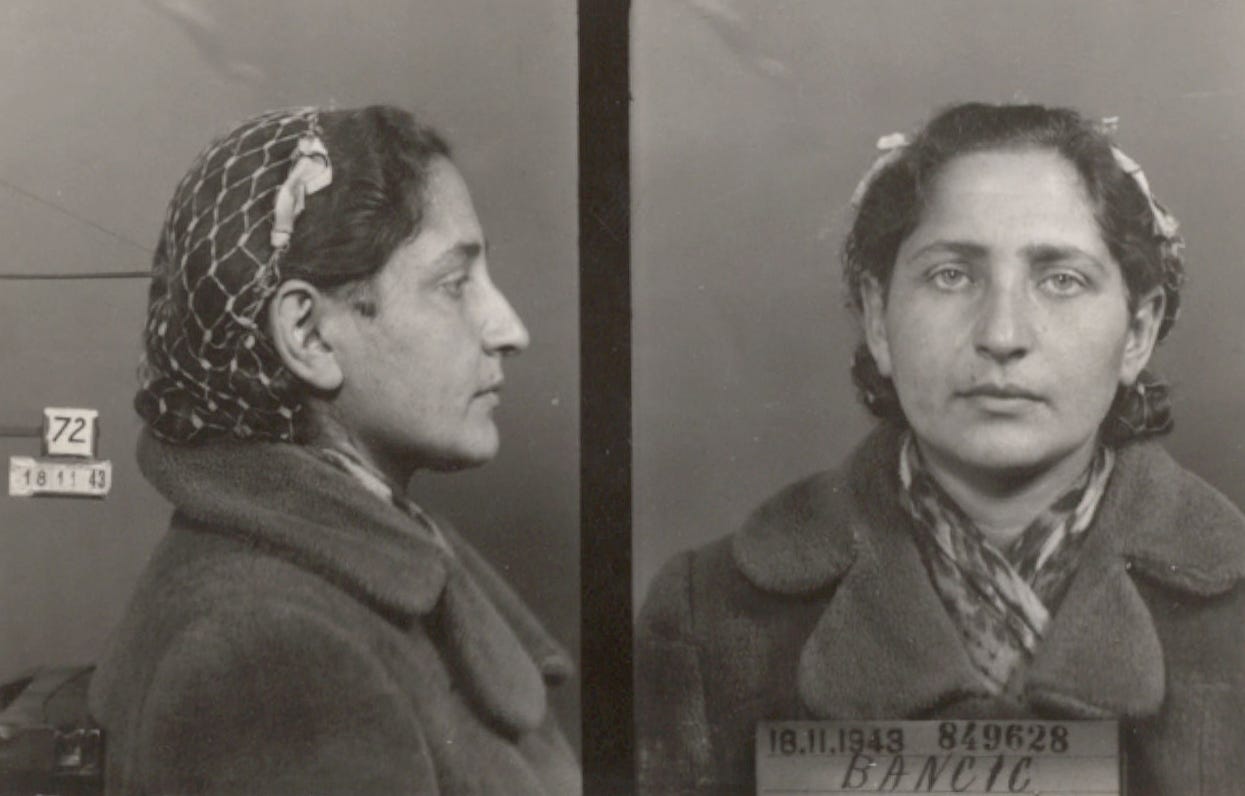You may never have heard of Olga Bancic (photo above, with her daughter Dolores). Once you know her story, you may not forget it. In February 1944 – 80 years ago this week – she became the last woman known to have been executed with an axe in Europe. She was decapitated by the Nazis as punishment for her resistance activities in France.
I came across Olga’s life and terrible death in a roundabout way. Our younger daughter has come home for half-term from her English boarding school. She has brought a friend whose father accompanied her for what was intended as a skiing holiday. They tried to ski on Monday, but the slopes were in terrible condition – it has stayed too warm too long.
So off we went to Lyon on Wednesday for a day of shopping (the girls) and sightseeing (the grown-ups). Wandering across the Pont Bonaparte towards the Place Bellecour – the fifth biggest square in France and the city’s kilométre zero (the point from which all distances are measured) – I spotted a small crowd waving red flags adorned with hammers and sickles.
Communism may be out of favour in most of western Europe, but old habits die hard in France. Marxist-Leninist longings still guide several of the country’s noisiest trade unions. From a distance it looked as though the proletariat was rattling its chains once more.
This time, though, it wasn’t a protest march. It was a tribute to one of the most remarkable figures in the annals of French Communism. The crowd was standing before a monument to members of the French resistance killed by the Germans during the Second World War.
In Paris later on Wednesday, President Emmanuel Macron conducted a ceremony of state at the Pantheon, the domed shrine to Gallic glory that shelters the tombs, among others, of Voltaire, Dumas and Zola; Marie Curie and Louis Braille.
To that list of illustrious names was added on Wednesday the first foreigners and first Communists to be accorded the ultimate French honour – known here as “panthéonisation”. Soldiers of the Foreign Legion carried the remains of a pair of Armenian-born immigrants into the crypt reserved for officially-designated national heroes.
Photo: Ministry of Culture website
Missak Manouchian, a poet turned partisan leader, and his wife, Melinée Manouchian, were honoured for the courage and commitment they both displayed in resisting Nazi occupation. The Manouchian network of 50 or so mostly Communist partisans carried out more than two dozen attacks on German targets in the second half of 1943, including the assassination of a top SS general.
The network counted among the most active and successful of France’s mostly ragged resistance units. But Manouchian was betrayed in late 1943 by one of its members who, under torture, told French collaborationist police where to find the network leader and many of his Communist comrades.
Arrests followed swiftly and after a short show trial, Manouchian and 22 members of his group were found guilty of carrying out 37 attacks and 14 train derailments. They were all sentenced to death and shot by a firing squad composed of German soldiers on 21 February 1944. His wife had managed to escape arrest and was sentenced to death in absentia (she survived the war and died in 1989).
Photos: Melinée and Missak Manouchian - from L’Humanité
It was a long time before France was ready to acknowledge the role played by foreign fighters and communist partisans in resisting the Nazis; this week’s “panthéonisation” was the culmination of a long campaign to dispel the rosy home-grown resistance glow that still distorts the national memory of German occupation. Far more French people collaborated with monsters, rather than oppose them. The heroes of the Resistance were not all French.
Listening to union speakers praising the Manouchians in Lyon this week made me wonder about their story. Returning home, I quickly came across the shattering texts of two letters, each written from the Nazi equivalent of death row; the first to a wife, the second to a daughter. Reading the second, I unexpectedly burst into tears.
The first was written by Manouchian himself shortly before his execution. Addressed to “My dear Melinée, my beloved little orphan”, it begins: “In a few hours I will no longer be of this world…. I joined the Army of Liberation as a volunteer, and I die within inches of victory”. He asked his wife to publish his poems, and as his last wish, urged her to remarry after his death to have the child she longed for. “I would so much have liked to have a child with you, as you always wished”.
The letter, published later, became a testament to the power of love in war; it inspired the poet Louis Aragon to write Strophes pour se souvenir (Verses for remembering), a tribute to foreign Resistance heroes. It was later set to music by the composer and singer Léo Ferré under the title L’Affiche Rouge (The Red Poster, a reference to Nazi propaganda posters denouncing the Manouchian network as ‘terrorists’). Manouchian’s letter is a beautiful document, but for me, not quite as affecting as Olga Bancic’s hastily scribbled note to her daughter.
Of the 23 resistants put on trial in 1943, one was a woman. Born in Romania in 1912, Golda Bancic was a Jewish Communist who sought refuge in France in 1936 as the Romanian monarchy turned to fascism. Married to a Romanian writer, Salomon Jacob, she changed her first name to Olga and gave birth to a daughter, Dolores, named for Dolores Ibarriru, La Pasionaria of the Spanish civil war.
When the Germans marched into France, Olga left Dolores in the care of a French family and joined the Communist Francs-Tireurs (mavericks) et Partisans (FTP). She adopted the nom de guerre ‘Pierrette’, and helped carry guns and explosives for around 100 acts of sabotage aimed at weakening the German army.
Arrested by the Gestapo a few days before the rest of her network was rounded up, she was tried alongside Manouchian and 21 other male partisans and sentenced to death. What followed was bizarrely inhuman.
The French penal code at that time exempted women from execution by firing squad. I haven’t been able to establish exactly what prompted this dubious courtesy. This, after all, was the country that cheerfully guillotined Marie-Antoinette; that introduced death by boiling as a punishment for counterfeiting; and in 1750 sentenced a male offender to be hanged for copulating with a donkey (the donkey was spared the death penalty after the local parish priest submitted a plea to court that the beast was “a most honest creature”). Yet somehow it was deemed inappropriate for a woman to be shot.
Whatever the reason, Bancic was spared the grim line-up of partisans sent to a firing squad in the grounds of a military fort. Instead, the Germans were obliged to deport her to one of their own prisons in order to murder her any way they liked. On May 10th 1944, she was decapitated with an axe in Stuttgart. It was the day of her 32nd birthday.
Like Manouchian though, she found a way to leave some last words, written the day before her execution. Somewhere between her cell and the axeman, she managed to drop the note out of a window. Somehow, her message survived. It was addressed to the French Red Cross and had a separate note attached: “Dear Madame: I ask you to please give this letter to my little girl Dolores Jacob after the war. This is the last wish of a mother who will only live 12 more hours”.
The letter itself began: “My dear little daughter, my darling little love…..tomorrow at 6:00 on May 10, I will be no more. Don’t cry, my love, your mother doesn’t cry any more either”. You can read the rest of the text here, if you can bear it.”
Bancic won’t be going to the Pantheon, but France didn’t forget her entirely. In 2013 a memorial plaque was placed at her last home address in Paris; a small square off the Boulevard Voltaire in the 11th arrondissement is named after her. Her husband returned to Romania in 1943. Of Dolores I can find no trace.









